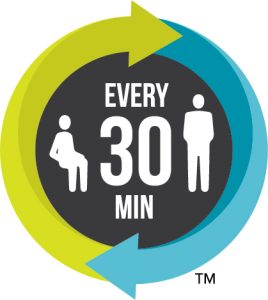The active office: you’ve likely heard about it in the news, and you’re convinced it’s the right thing to do, but how do you begin? How much should you move at work and how often? Will your manager and co-workers support the idea or see it as a distraction? Ultimately, will moving more at work make you more productive?
We think so.
At Ergotron, we are familiar with these concerns and more. We have been designing and manufacturing sit-stand solutions longer than anyone else in the business. At the same time, we also support independent scientific studies to broaden the public’s understanding of how intermittent low-level physical activity can help prevent disease and lead to increased job satisfaction and performance.
So does Lee Goodwin, a research associate working at the Institute of Sport Science and Sport at Friedrich-Alexander University of Erlangen-Nuremberg in Germany. He recently contacted Ergotron to share his thesis from his Master’s degree.* The thesis lays the theoretical groundwork for practical strategies to add movement into workplaces globally.
Using Lee’s research and decades of experience at Ergotron, we’ve compiled key lessons learned for incorporating movement into the office.
The Sit-Stand Switch™
 How much should you move and how often? In 2016, the American Heart Association issued a scientific advisory noting that it isn’t enough to tell people to be active–you have to tell them to sit less and to be more active. In our research, we have found that it’s possible to reduce sitting time at the office by 50% by using sit-stand workstations and switching postures every hour.
How much should you move and how often? In 2016, the American Heart Association issued a scientific advisory noting that it isn’t enough to tell people to be active–you have to tell them to sit less and to be more active. In our research, we have found that it’s possible to reduce sitting time at the office by 50% by using sit-stand workstations and switching postures every hour.
To build up to this ratio when transitioning from a traditional desk, take a few weeks to adjust to intermittent standing. Week one, start with 50 minutes of sitting and 10 minutes of standing each hour. In week two, try 40 minutes of sitting and 20 minutes of standing. Starting with week three, begin following the Sit-Stand Switch with 30 minutes of sitting followed by 30 minutes of standing.
Permission and policy: Two birds, one shot
Will your manager support the idea and will your co-workers tease you or worse, complain you’re being a distraction? Luckily, a single tactic hits both targets! The solution is to gain leadership support from the start. This may take some work on your part, but don’t worry, Ergotron has your back. You’ll find helpful resources on our website, including our WorkFit Champion Toolkit, to help employees address their needs with managers. Once management is on board, their permission gives your co-workers the freedom to freely practice healthy new behaviors. The next step is to institute policies that guide employees on how to choose the right ergonomic products and how to best use them.
Productivity depends on health and happiness
Will moving more at work have an impact on your productivity? The answer depends on the intensity of the physical activity. If the activity is too strenuous, your productivity levels may dip as you become tired instead of leaving you more energized and effective. Lee Goodwin, along with many physical activity researchers, place special emphasis on low-intensity physical activity in the office as opposed to moderate to vigorous physical activity, which is another way of saying exercise.
Research shows that more strenuous physical activity can negatively impact an employee’s work. Walking on a treadmill or using a stair-stepper can disrupt keyboard and/or mouse use and cause unnecessary fatigue. In my own experience using a treadmill desk, I tired myself out even when I kept my walking speed down. By the afternoon, my energy level was low. By using a sit-stand workstation, you’re less likely to push yourself too much, and you won’t experience additional errors or distractions.
Congratulations to Lee on attaining his Master’s degree! Thanks for contributing to the growing body of evidence that supports the movement toward active offices.
*The review that Lee conducted identified 148 Australian literature-based strategies that pertain to light intensity activity in the office-based workplace. Each individual strategy was then categorized under a set level of workplace operation: individual, social, environmental, organizational and policy.
This inventory of strategies was complemented with an ecological workplace model designed to advocate strategy enhancements in the office setting. The model consists of four unique domains that serve as facilitators for engagement and sustaining light intensity activity at work: structured breaks, unstructured breaks, structured working periods and unstructured working periods.
The intent was to ease employers’ concerns about how to implement and maintain an active workplace by understanding the positive impact on employee health and productivity.
Relevant Posts
Stay in the know
Sign up and get the latest and greatest content from JustStand's MoveMore blog.

